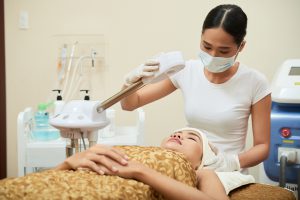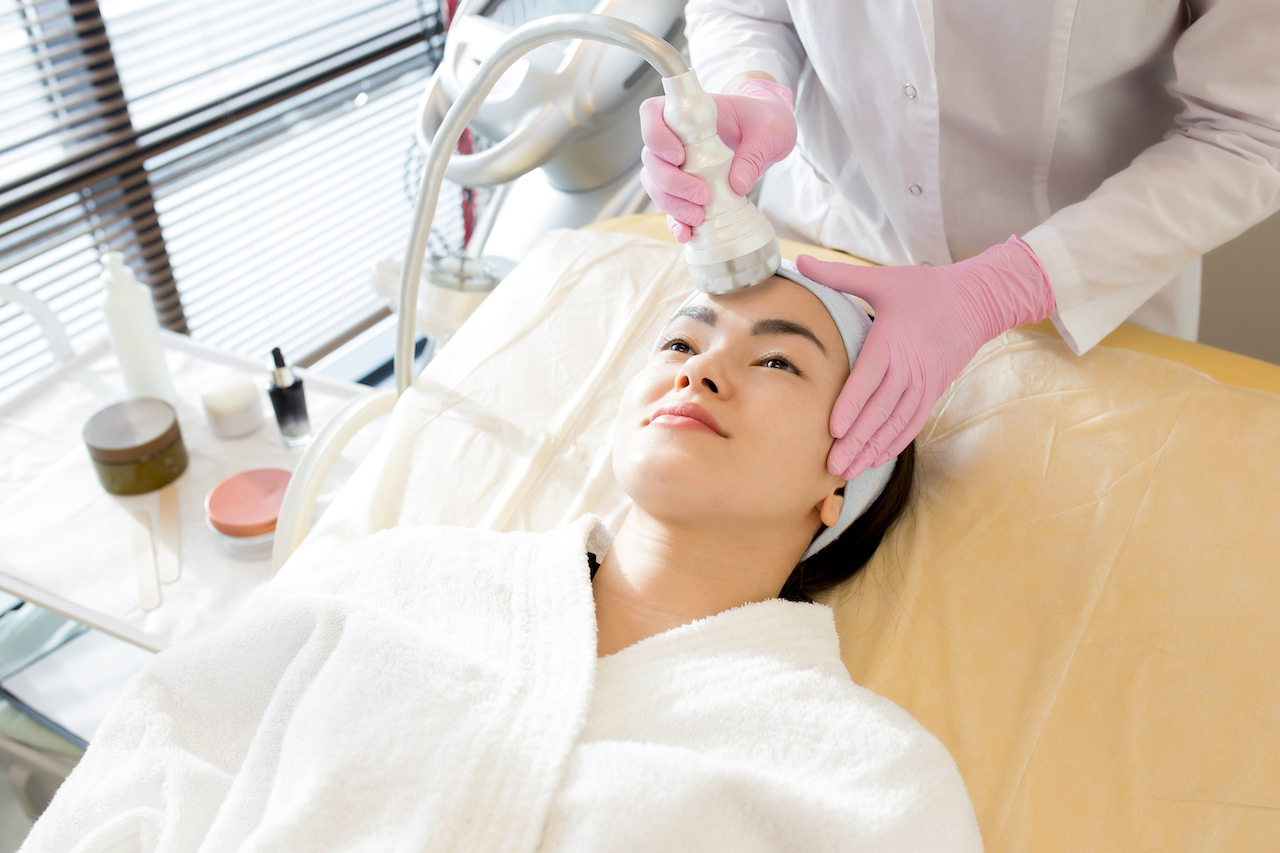To become an aesthetician, you’ll need to complete certain training courses before deciding whether you want to work for an existing company, or to start your own business.
You’ll also have to decide whether you want to pursue a career as a medical aesthetician, working in a clinical environment, or as a non-medical aesthetician.
In this post we’ll explore almost everything you need to know to start a new career as an aesthetician.

What Is An Aesthetician?
Aestheticians perform specialised skincare treatments. There are two main types of aestheticians; medical, who work in healthcare settings, and non-medical, who work in cosmetic or salon environments.
Medical aestheticians might work with dermatologists in clinical and healthcare settings to perform medical skincare procedures. This might include treating skin damaged by burns, surgery, and chemotherapy.
Then there are non-medical aestheticians. Also known as skincare specialists or facialists, they work in cosmetic and salon environments and provide non-medical skincare services. This might include treatment for dry skin or acne, or even certain relaxing or therapeutic services.
What’s The Difference Between an Aesthetician and an Esthetician?
An esthetician is a sort of beautician. They’ll use various techniques, including exfoliation and waxing, to help their clients look and feel relaxed, refreshed, and rejuvenated. An esthetician might also give clients a makeover.
An aesthetician provides more advanced treatments, including skin resurfacing, laser peels, and sclerotherapy. Some aestheticians might even be qualified to give Botox and filler injections.
You can read our full guide to the differences between an aesthetician and an esthetician. This guide also contains advice on starting a career as an esthetician.
So What Does an Aesthetician Do?
The work you do as an aesthetician will depend on whether you’re a medical or a non-medical aesthetician. The process will always begin with inspecting a client’s skin to identify problem areas, before discussing possible treatment plans. This is why good interpersonal skills are a must for aestheticians.
Non-Medial Aesthetician Treatments
Non-medical aestheticians might then provide the following treatments:
- Cleansing, exfoliating, and massaging the client’s skin.
- Hair removal treatments, such as tweezing, waxing, and threading.
- Preparing clients for injection treatments.
- Advanced cosmetic treatments, including body sculpting.
- Advising the client on the best skincare products to use, and on how to use them.
Treatments Given By a Medial Aestheticians
On the other hand, medical aestheticians might perform more invasive treatments that offer more permanent results:
- Skin resurfacing, including laser peels.
- Permanent and semi-permanent makeup treatment.
- Sclerotherapy treatment for varicose veins.
- Lymphatic drainage massages.
- Skin tightening procedures.
Both medical and non-medical aestheticians will provide aftercare services. This will usually involve advising clients on the correct procedures to take to ensure the treatment’s lasting success.
What Qualifications Do You Need to Become an Aesthetician in the UK?
All aestheticians need extensive training in advanced skincare, but it should be obvious by now that medical aestheticians need more specialist training!
Here are some of the qualifications that could help you get started as an aesthetician:
- GCSEs – Some vocational courses may specify entry requirements, including a few GCSEs in certain subjects. Not all of them do, but it’s a good idea to finish secondary school before you pursue your career.
- Vocational Studies – Start with an NVQ in facial and skincare. Then pursue further studies in whichever treatments you want to provide, whether that’s chemical peels or micro-needling.
- Further Education – If you want to become a medical aesthetician, you’ll have to take a higher education course in nursing and specialised aesthetic training. You’ll also have to register with the Nursing and Midwifery Council.
How To Get Started as an Aesthetician in the UK
Once you’ve finished your vocational studies, it’s a good idea to find practical work experience in a salon or spa. Even if you ultimately intend to set up your own aesthetician business, this will help you to hone your new skills through practicing in a “real-world” environment. You’ll also get to sample the day-to-day demands of working as an aesthetician, from chatting with clients to advising on post-treatment care.
After a period of work experience, you’ll have a portfolio full of your successful treatments, along with a good network of contacts, references, and satisfied customers. All of this will prove invaluable as you continue your career, whether you want to find work in another salon or spa, or you want to make a name for yourself as an independent aesthetician.
If you’re aiming to work as a medical aesthetician in a clinical environment, along with your further studies you’ll also have to acquire a minimum of three years’ experience in adult nursing. This is why most medical aestheticians study nursing alongside the specialist skincare treatments.
How to Become an Aesthetician – Other Things to Think About
You can have a rewarding long-term career working as an aesthetician in a salon, spa, or gym setting – or in a hospital or clinic as a medical aesthetician.
But you can enjoy a lot more independence – and potentially earn a lot more money – if you set up your own aesthetician business. Medical aestheticians might also choose to set up their own independent clinic.
At this point, you’re probably more concerned about getting your qualifications than starting a business. But when you’re ready, you’ll find plenty of guides on our site to help you set yourself up as an independent aesthetician:
- How to register your business – whether as a sole trader, a partnership, or a limited company.
- A guide to keeping good financial records.
- Why you need a business bank account.
Insurance for Aestheticians
Any treatment you provide as an aesthetician will come with certain risks. The wrong product could cause an allergic reaction, and a slight mistake on your part could result in serious injury.
So whether you’re an independent aesthetician or you’re working for someone else, it’s vital that you get adequate insurance cover.
Here are some of the types of cover that all aestheticians might consider:
- Professional Indemnity Insurance. Cover for any mistakes you might make during a procedure. For example, if you advise a client on a course of treatment, and they’re unsatisfied with the results, they could make a claim against you. Professional indemnity insurance can cover any legal fees arising from such a claim. Learn more about professional indemnity insurance.
- Treatment Liability Insurance. If you accidentally harm a client during a procedure, they might be entitled to compensation. As well as covering your legal fees, treatment liability insurance can also cover any damages your client might be due. Learn more about treatment liability insurance.
- Contents Insurance. As an aesthetician you’ll work with a lot of specialist equipment and products. Contents insurance will cover you for any loss, damage, or theft. Learn more about contents insurance.
We offer specialist insurance cover tailored to suit the needs of self-employed freelancers and small business owners. Our cover starts at 35p a day, and you can get a free quote online in minutes.
If you have any questions or would like to discuss your options, please contact the Tapoly team at info@tapoly.com, call our helpline on +44(0)2078 460 108 or try our chat on our website.

